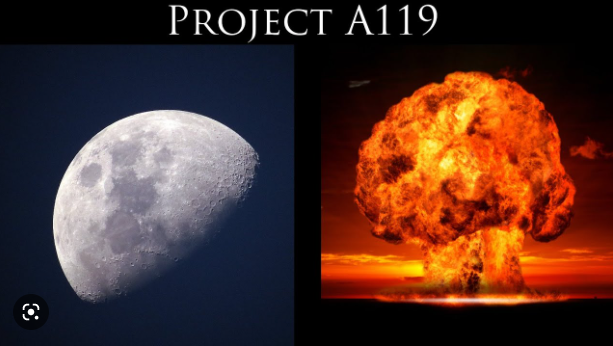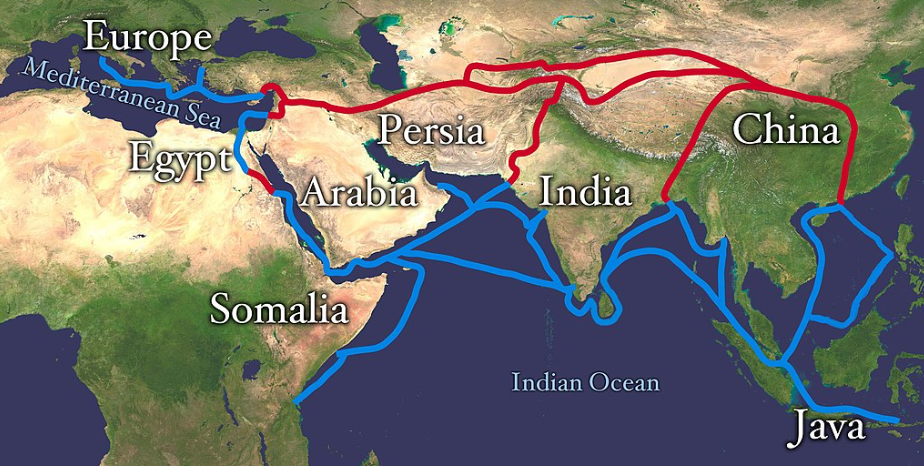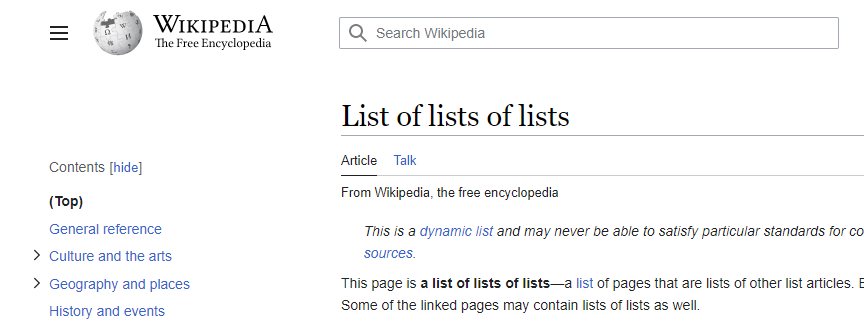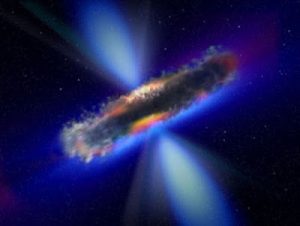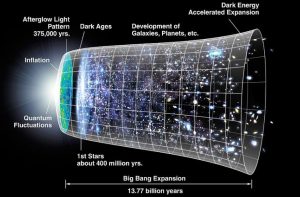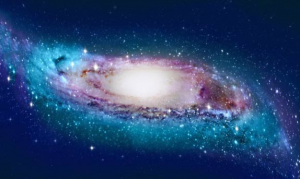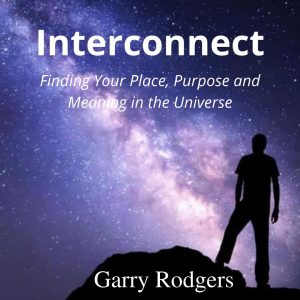 As a commercial content producer, I learned early in the business never to directly quote Wikipedia as reference material. It was fair game, however, to exploit The Wik and springboard (rabbithole) from there to find fact-checkable links used to support whatever article I was writing. Wikipedia is a good site to help meet deadlines by sourcing general information, but it can be a terrible time suck when you get lost in the weird ‘n wacky world of Wikipedia.
As a commercial content producer, I learned early in the business never to directly quote Wikipedia as reference material. It was fair game, however, to exploit The Wik and springboard (rabbithole) from there to find fact-checkable links used to support whatever article I was writing. Wikipedia is a good site to help meet deadlines by sourcing general information, but it can be a terrible time suck when you get lost in the weird ‘n wacky world of Wikipedia.
I opened my Morning Brew email newsletter the other day (if you don’t subscribe to the Morning Brew, you’re missing out) and there was a link to a site run by Sam Enright. I’d never heard of the guy, but his headline caught my eye. It read The Cabinet of Wikipedia Curiosities so I checked it out. Well, I fell into a deep void and stayed submerged for most of the morning.
I figured if I could burn up three or four hours sifting through pointless drivia about the world’s wackiest and weird stuff, then you should, too. That’s why today’s DyingWords post is titled The Weird ‘n Wacky World of Wikipedia. Here’s the goods and the links straight from The Wik.
 The Mechanical Turk, also known as the Automaton Chess Player, was a fraudulent chess-playing machine constructed in the late 18th century. From 1770 until its destruction by fire in 1854 it was exhibited by various owners as an automaton, though it was eventually revealed to be an elaborate hoax.
The Mechanical Turk, also known as the Automaton Chess Player, was a fraudulent chess-playing machine constructed in the late 18th century. From 1770 until its destruction by fire in 1854 it was exhibited by various owners as an automaton, though it was eventually revealed to be an elaborate hoax.
and unveiled in 1770 by Wolfgang von Kempelen (1734–1804) to impress Empress Maria Theresa of Austria, the mechanism appeared to be able to play a strong game of chess against a human opponent, as well as perform the knight’s tour, a puzzle that requires the player to move a knight to occupy every square of a chessboard exactly once.
(Turns out the scam was just a really smart, chess-master midget in the box.)
 Phineas P. Gage was an American railroad construction foreman known for his improbable survival of an accident in which a large iron rod was driven completely through his head, destroying much of his brain’s left frontal lobe, and for that injury’s reported effects on his personality and behavior over the remaining 12 years of his life—effects sufficiently profound that friends saw him (for a time at least) as “no longer Gage”.
Phineas P. Gage was an American railroad construction foreman known for his improbable survival of an accident in which a large iron rod was driven completely through his head, destroying much of his brain’s left frontal lobe, and for that injury’s reported effects on his personality and behavior over the remaining 12 years of his life—effects sufficiently profound that friends saw him (for a time at least) as “no longer Gage”.
Long known as the “American Crowbar Case”—once termed “the case which more than all others is calculated to excite our wonder, impair the value of prognosis, and even to subvert our physiological doctrines” —Phineas Gage influenced 19th-century discussion about the mind and brain, particularly debate on cerebral localization, and was perhaps the first case to suggest the brain’s role in determining personality, and that damage to specific parts of the brain might induce specific mental changes.
(It’s the only medically recorded case of someone turning from a super nice guy to a total asshole without applying alcohol.)
Michel Lotito was a French entertainer, born in Grenoble, famous for deliberate consumption of indigestible objects. He came to be known as Monsieur “Mouth” Mangetout (“Mr. Eat-All”). He started eating this unusual diet at age 9.
 Michel Lotito began eating unusual material at 9 years of age, and he performed publicly beginning in 1966. He had an eating disorder known as pica, which is a psychological disorder characterized by an appetite for substances that are largely non-nutritive. Doctors determined that Lotito also had a thick lining in his stomach and intestines which allowed his consumption of sharp metal without suffering injury. Lotito also had digestive juices that were unusually powerful, meaning that he could digest the unusual materials. However, it also meant that soft foods, such as bananas and hard-boiled eggs, made him sick.
Michel Lotito began eating unusual material at 9 years of age, and he performed publicly beginning in 1966. He had an eating disorder known as pica, which is a psychological disorder characterized by an appetite for substances that are largely non-nutritive. Doctors determined that Lotito also had a thick lining in his stomach and intestines which allowed his consumption of sharp metal without suffering injury. Lotito also had digestive juices that were unusually powerful, meaning that he could digest the unusual materials. However, it also meant that soft foods, such as bananas and hard-boiled eggs, made him sick.
Lotito’s performances involved the consumption of metal, glass, rubber and other materials. He disassembled, cut up, and consumed items such as bicycles, shopping carts, televisions, and a Cessna 150, among other items. The Cessna 150 took roughly two years to be “eaten”, from 1978 to 1980.
Lotito claimed not to suffer ill effects from his consumption of substances typically considered poisonous. When performing, he ingested approximately 1 kilogram (2.2 lb) of material daily, preceding it with mineral oil and drinking considerable quantities of water during the meal. It is estimated that between 1959 and 1997, Lotito “had eaten nearly nine tons of metal.”
Lotito’s method for eating all of this metal was to break it into small pieces before attempting to eat it. He then drank mineral oil and continued to drink water while swallowing the metal bits. This acted as a lubricant to help the metal slide down his throat. Lotito had no problem “passing” his unusual diet.
(I wonder – If he ate a stealth bomber would he turn invisible?)
Project A119, also known as A Study of Lunar Research Flights, was a top-secret plan developed in 1958 by the United States Air Force. The aim of the project was to detonate a nuclear bomb on the Moon, which would help in answering some of the mysteries in planetary astronomy and astrogeology. If the explosive device detonated on the surface, and not in a lunar crater, the flash of explosive light would have been faintly visible to people on Earth with their naked eye. This was meant as a show of force resulting in a possible boosting of domestic morale in the capabilities of the United States, a boost that was needed after the Soviet Union took an early lead in the Space Race and was also working on a similar project.
The project was never carried out, being cancelled after “Air Force officials decided its risks outweighed its benefits”, and because a Moon landing would undoubtedly be a more popular achievement in the eyes of the American and international public alike. If executed, the plan might have led to a potential militarization of space. A similar project by the Soviet Union (Project E-4) also never came to fruition.
The existence of the US project was revealed in 2000 by a former executive at the National Aeronautics and Space Administration (NASA), Leonard Reiffel, who had led the project in 1958. A young Carl Sagan was part of the team responsible for predicting the effects of a nuclear explosion in vacuum and low gravity and evaluating the scientific value of the project. The relevant documents remained secret for nearly 45 years and, despite Reiffel’s revelations, the United States government has never officially acknowledged its involvement in the study.
(You have to wonder what the moon ever did to deserve getting nuked.)
The Emu War was a nuisance wildlife management turned full-scale military operation undertaken in Australia over the later part of 1932 to address public concern over the number of emus said to be running amok and destroying crops in the Campion district within the Wheatbelt of Western Australia. The unsuccessful attempts to curb the population of emus, a large flightless bird indigenous to Australia, employed Royal Australian Artillery soldiers armed with Lewis fully-automatic machine guns—leading the media to adopt the name “Emu War” when referring to the incident. While a number of the birds were killed, the emu population persisted and continued to cause crop destruction.
 Military involvement was due to begin in October 1932. The “war” was conducted under the command of Major Gwynydd Purves Wynne-Aubrey Meredith of the Seventh Heavy Battery of the Royal Australian Artillery, with Meredith commanding soldiers Sergeant S. McMurray and Gunner J. O’Halloran,] armed with two Lewis machine guns and 10,000 rounds of ammunition. The operation was delayed, however, by a period of rainfall that caused the emus to scatter over a wider area.] The rain ceased by 2 November 1932, whereupon the troops were deployed with orders to assist the farmers and, according to a newspaper account, to collect 100 emu skins so that their feathers could be used to make hats for light horsemen
Military involvement was due to begin in October 1932. The “war” was conducted under the command of Major Gwynydd Purves Wynne-Aubrey Meredith of the Seventh Heavy Battery of the Royal Australian Artillery, with Meredith commanding soldiers Sergeant S. McMurray and Gunner J. O’Halloran,] armed with two Lewis machine guns and 10,000 rounds of ammunition. The operation was delayed, however, by a period of rainfall that caused the emus to scatter over a wider area.] The rain ceased by 2 November 1932, whereupon the troops were deployed with orders to assist the farmers and, according to a newspaper account, to collect 100 emu skins so that their feathers could be used to make hats for light horsemen
Despite the problems encountered with the cull, the farmers of the region once again requested military assistance in 1934, 1943, and 1948, only to be turned down by the government. Instead, the bounty system that had been instigated in 1923 was continued, and this proved to be effective: 57,034 bounties were claimed over a six-month period in 1934.
By December 1932, word of the Emu War had spread, reaching the United Kingdom. Some conservationists there protested the cull as “extermination of the rare emu”. Dominic Serventy and Hubert Whittell, the eminent Australian ornithologists, described the “war” as “an attempt at the mass destruction of the birds”.
 Throughout 1930 and onward, exclusion barrier fencing became a popular means of keeping emus out of agricultural areas (in addition to other vermin, such as dingoes and rabbits).
Throughout 1930 and onward, exclusion barrier fencing became a popular means of keeping emus out of agricultural areas (in addition to other vermin, such as dingoes and rabbits).
In November 1950, Hugh Leslie raised the issues of emus in federal parliament and urged Army Minister Josiah Francis to release a quantity of .303 ammunition from the army for the use of farmers. The minister approved the release of 500,000 rounds of ammunition.
In 2019, a musical adaptation of the story was workshopped in Melbourne by playwright Simeon Yialeloglou and composer James Court. An action-comedy movie retelling of the events, written by John Cleese, Monty Franklin, and Rob Schneider, was originally slated for release in 2022, now scheduled to begin production in 2023.
(Score: Emus 1 Soldiers 0)
Acoustic Kitty was a Central Intelligence Agency (CIA) project launched by the Central Intelligence Agency Directorate of Science & Technology in the 1960s, which intended to use cats to spy on the Kremlin and Soviet embassies.
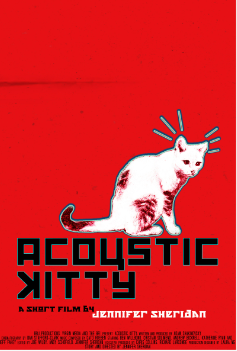 In an hour-long procedure, a veterinary surgeon implanted a microphone in the cat’s ear canal, a small radio transmitter at the base of its skull, and a thin wire into its fur. This would allow the cat to innocuously record and transmit sound from its surroundings. Due to problems with distraction, the cat’s sense of hunger had to be addressed in another operation. Victor Marchetti, a former CIA officer, said Project Acoustic Kitty cost about $20 million.
In an hour-long procedure, a veterinary surgeon implanted a microphone in the cat’s ear canal, a small radio transmitter at the base of its skull, and a thin wire into its fur. This would allow the cat to innocuously record and transmit sound from its surroundings. Due to problems with distraction, the cat’s sense of hunger had to be addressed in another operation. Victor Marchetti, a former CIA officer, said Project Acoustic Kitty cost about $20 million.
The first Acoustic Kitty mission was to eavesdrop on two men in a park outside the Soviet embassy in Washington, D.C. The cat was released nearby but was hit and allegedly killed by a taxi almost immediately. However, this was disputed in 2013 by Robert Wallace, a former director of the CIA’s Office of Technical Service, who said that the project was abandoned due to the difficulty of training the cat to behave as required, and “the equipment was taken out of the cat; the cat was re-sewn for a second time and lived a long and happy life afterwards”. Subsequent tests also failed. Shortly thereafter the project was considered a failure and declared to be a total loss. However, other accounts report more success for the project.
The project was cancelled in 1967. A closing memorandum said that the CIA researchers believed that they could train cats to move short distances, but that “the environmental and security factors in using this technique in a real foreign situation force us to conclude that for our (intelligence) purposes, it would not be practical.” The project was disclosed in 2001, when some CIA documents were declassified.
(I’m sure the Get Smart writers would be proud.)
Phallic Architecture consciously or unconsciously creates a symbolic representation of the human penis. Buildings intentionally or unintentionally resembling the human penis are a source of amusement to locals and tourists in various places around the world. Deliberate phallic imagery is found in ancient cultures and in the links to ancient cultures found in traditional artifacts.
The ancient Greeks and Romans celebrated phallic festivals and built a shrine with an erect phallus to honor Hermes, messenger of the gods. Those figures may be related to the ancient Egyptian deity Min who was depicted holding his erect phallus. Figures of women with a phallus for a head have been found across Greece and Yugoslavia. Phallic symbolism was prevalent in the architectural tradition of ancient Babylon. The Romans, who were deeply superstitious, also often used phallic imagery in their architecture and domestic items. The ancient cultures of many parts of the Far East, including Indonesia, India, Korea and Japan, used the phallus as a symbol of fertility in motifs on their temples and in other areas of everyday life.
Scholars of anthropology, sociology, and feminism have alleged a symbolic nature of phallic architecture, especially large skyscrapers which dominate the landscape, supposedly as symbols of male domination, power and political authority. Towers and other vertical structures may unintentionally or perhaps subconsciously have those connotations. There are many examples of modern architecture that can be interpreted as phallic, but very few for which the architect has specifically cited or admitted that meaning as an intentional aspect of the design.
(I wonder if that’s where the term “erect” a building comes from.)
Tycho Brahe was a Danish astronomer, known for his comprehensive astronomical observations, generally considered to be the most accurate of his time. He was known during his lifetime as an astronomer, astrologer, and alchemist. He was the last major astronomer before the invention of the telescope.
An heir to several noble families, Tycho was well-educated. He took an interest in astronomy and in the creation of more accurate instruments of measurement. He worked to combine what he saw as the geometrical benefits of Copernican heliocentrism with the philosophical benefits of the Ptolemaic system, and devised the Tychonic system, his own version of a model of the Universe, with the Sun orbiting the Earth, and the planets as orbiting the Sun. In De nova stella (1573), he refuted the Aristotelian belief in an unchanging celestial realm. His measurements indicated that “new stars” (stellae novae, now called supernovae) moved beyond the Moon, and he was able to show that comets were not atmospheric phenomena, as was previously thought.
King Frederick II granted Tycho an estate on the island of Hven and the money to build Uraniborg, the first large observatory in Christian Europe. He later worked underground at Stjerneborg, where he realised that his instruments in Uraniborg were not sufficiently steady. He treated the island residents as if he were an autocrat; they unsuccessfully sued him over their treatment. In 1597, he was forced by the new king, Christian IV, to leave Denmark. He was invited to Prague, where he became the official imperial astronomer, and built an observatory at Benátky nad Jizerou. Prior to his death in 1601, he was assisted for a year by Johannes Kepler, who went on to use Tycho’s data to develop his own three laws of planetary motion.
In 1566, Tycho left to study at the University of Rostock. Here, he studied with professors of medicine at the university’s famous medical school and became interested in medical alchemy and herbal medicine.] On 29 December 1566 at the age of 20, Tycho lost part of his nose in a sword duel with a fellow Danish nobleman, his third cousin Manderup Parsberg. The two had drunkenly quarreled over who was the superior mathematician at an engagement party at the home of Professor Lucas Bachmeister on 10 December.
Coming nearly to quarrel again with his cousin on 29 December, they ended up resolving their feud with a duel in the dark. Though the two were later reconciled, the duel resulted in Tycho losing the bridge of his nose and gaining a broad scar across his forehead. He received the best possible care at the university and wore a prosthetic nose for the rest of his life. It was kept in place with paste or glue and said to be made of silver and gold.
In November 2012, Danish and Czech researchers reported that the prosthetic was actually made of brass after chemically analyzing a small bone sample from the nose from the body exhumed in 2010. The prosthetics made of gold and silver were mostly worn for special occasions, rather than everyday wear.
(One extra about Tycho Brahe. He kept a pet elk in his house and fed it fermented fruit. One time the elk got so drunk that it fell down the stairs.)
John Romulus Brinkley (later John Richard Brinkley; July 8, 1885 – May 26, 1942) was an American quack. He had no properly accredited education as a physician and bought his medical degree from a “diploma mill”. Brinkley became known as the “goat-gland doctor” after he achieved national fame, international notoriety and great wealth through the xenotransplantation of goat testicles into humans.
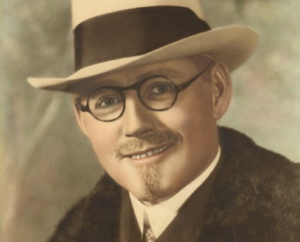 Although initially Brinkley promoted this procedure as a means of curing male impotence, he later claimed that the technique was a virtual panacea for a wide range of male ailments. Brinkley operated clinics and hospitals in several states and was able to continue practicing medicine for almost two decades despite his techniques being thoroughly discredited by the broader medical community.
Although initially Brinkley promoted this procedure as a means of curing male impotence, he later claimed that the technique was a virtual panacea for a wide range of male ailments. Brinkley operated clinics and hospitals in several states and was able to continue practicing medicine for almost two decades despite his techniques being thoroughly discredited by the broader medical community.
He was also, almost by accident, an advertising and radio pioneer who began the era of Mexican border blaster radio.
Although he was stripped of his license to practice medicine in Kansas and several other states, Brinkley, a demagogue beloved by hundreds of thousands of people in Kansas and elsewhere, nevertheless launched two campaigns for Kansas governor, one of which was nearly successful. Brinkley’s rise to fame and fortune was as quick as his eventual fall was precipitous. At the height of his career he had amassed millions of dollars, but he died nearly penniless as a result of the large number of malpractice, wrongful death and fraud suits brought against him.
(Goat nuts? Ah, pass.)
Raising of Chicago: During the 1850s and 1860s, engineers carried out a piecemeal raising of the level of central Chicago to lift it out of low-lying swampy ground. Streets, sidewalks, and buildings were physically raised on jackscrews. The work was funded by private property owners and public funds.
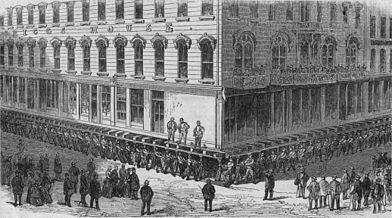 During the 19th century, the elevation of the Chicago area was little higher than the shoreline of Lake Michigan; for many years, there was little or no naturally occurring drainage from the city surface. The lack of drainage caused unpleasant living conditions and standing water harbored pathogens that caused numerous epidemics, including typhoid fever and dysentery, which blighted Chicago six years in a row, culminating in the 1854 outbreak of cholera that killed six percent of the city’s population.
During the 19th century, the elevation of the Chicago area was little higher than the shoreline of Lake Michigan; for many years, there was little or no naturally occurring drainage from the city surface. The lack of drainage caused unpleasant living conditions and standing water harbored pathogens that caused numerous epidemics, including typhoid fever and dysentery, which blighted Chicago six years in a row, culminating in the 1854 outbreak of cholera that killed six percent of the city’s population.
The crisis forced the city’s engineers and aldermen to take the drainage problem seriously and after many heated discussions—and following at least one false start—a solution eventually materialized. In 1856, engineer Ellis S. Chesbrough drafted a plan for the installation of a citywide sewerage system and submitted it to the Common Council, which adopted the plan. Workers then laid drains, covered and refinished roads and sidewalks with several feet of soil, and raised most buildings to the new grade.
(Chicago is next on my travel list – it seems like its filled with fascinating stuff like this.)
Smuggling of Silkworm Eggs into the Byzantine Empire: In the mid-6th century CE, two monks, with the support of the Byzantine emperor Justinian I, acquired and smuggled living silkworms into the Byzantine Empire, which led to the establishment of an indigenous Byzantine silk industry that long held a silk monopoly in Europe.
Silk, which was first produced sometime during the third millennium BCE by the Chinese and/or Indus Valley Civilisation, was a valuable trade commodity along the Silk Road. By the first century CE, there was a steady flow of silk into the Roman Empire.
With the rise of the Sassanid Empire and the subsequent Roman–Persian Wars, importing silk to Europe became increasingly difficult and expensive. The Persians strictly controlled trade in their territory and would suspend trade in times of war. Consequently, the Byzantine Emperor Justinian I tried creating alternative trade routes to Sogdiana, which at the time had become a major silk-producing centre: one to the north via Crimea, and one to the south via Ethiopia. The failure of these efforts led Justinian I to look elsewhere.
Two unidentified monks (most likely members of the Nestorian Church) who had been preaching Christianity in India (Church of the East in India), made their way to China by 551 CE. While they were in China, they observed the intricate methods for raising silkworms and producing silk. This was a key development, as the Byzantines had previously thought silk was made in India. In 552 CE, the two monks sought out Justinian I. In return for his generous but unknown promises, the monks agreed to acquire silkworms from China. They most likely traveled a northern route along the Black Sea, taking them through the Transcaucasus and the Caspian Sea.
Since adult silkworms are rather fragile and have to be constantly kept at an ideal temperature, lest they perish, they used their contacts in Sogdiana to smuggle out silkworm eggs or very young larvae instead, which they hid within their bamboo canes. Mulberry bushes, which are required for silkworms, were either given to the monks or already imported into the Byzantine Empire. All in all, it is estimated that the entire expedition lasted two years.
 Shortly after the expedition there were silk factories in Constantinople, Beirut, Antioch, Tyre, and Thebes. The acquired silkworms allowed the Byzantine Empire to have a silk monopoly in Europe. The acquisition also broke the Chinese and Persian silk monopolies. The resulting monopoly was a foundation for the Byzantine economy for the next 650 years until its demise in 1204. Silk clothes, especially those dyed in imperial purple, were almost always reserved for the elite in Byzantium, and their wearing was codified in sumptuary laws. Silk production in the region around Constantinople, particularly in Thrace in northern Greece, has continued to the present.
Shortly after the expedition there were silk factories in Constantinople, Beirut, Antioch, Tyre, and Thebes. The acquired silkworms allowed the Byzantine Empire to have a silk monopoly in Europe. The acquisition also broke the Chinese and Persian silk monopolies. The resulting monopoly was a foundation for the Byzantine economy for the next 650 years until its demise in 1204. Silk clothes, especially those dyed in imperial purple, were almost always reserved for the elite in Byzantium, and their wearing was codified in sumptuary laws. Silk production in the region around Constantinople, particularly in Thrace in northern Greece, has continued to the present.
In Season 1, Episode 4 of the Netflix series Marco Polo, released in 2014, two men are caught smuggling silkworms in their walking sticks. Kublai Khan must decide whether or not to kill them for their crime, which is punishable by death, but he ultimately shows mercy and allows Marco Polo to decide their fate.
(A bit of info on me: I collect neckties and almost all are made from silk, mostly Italian.)
The Pig War was a confrontation in 1859 between the United States and the United Kingdom over the British–U.S. border in the San Juan Islands, between Vancouver Island (present-day Canada) and the State of Washington. The Pig War, so called because it was triggered by the shooting of a pig, is also called the Pig Episode, the Pig and Potato War, the San Juan Boundary Dispute, and the Northwestern Boundary Dispute. Despite being referred to as a “war” there were no casualties on either side, aside from the pig.
On June 15, 1859, exactly 13 years after the adoption of the Oregon Treaty, the ambiguity led to direct conflict. Lyman Cutlar, an American farmer who had moved onto San Juan Island claiming rights to live there under the Donation Land Claim Act, found a pig rooting in his garden and eating his tubers. This was not the first occurrence and as a result Cutlar shot the pig, killing it. It turned out that the pig was owned by an Irishman, Charles Griffin, who was employed by the Hudson’s Bay Company to run the sheep ranch on the island. He also owned several pigs that he allowed to roam freely.
The two had lived in peace until this incident. Cutlar offered $10 (equivalent to $300 in 2021) to Griffin to compensate for the pig, but Griffin was unsatisfied with this offer and demanded $100 (equivalent to $3,000 in 2021). Following this reply, Cutlar believed he should not have to pay for the pig because the pig had been trespassing on his land. One likely apocryphal account has Cutlar saying to Griffin, “It was eating my potatoes”; and Griffin replying, “It is up to you to keep your potatoes out of my pig.” When British authorities threatened to arrest Cutlar, American settlers called for military protection.
(BTW, I live right in this region and have boated throughout the islands.)
The Great Molasses Flood, also known as the Boston Molasses Disaster, was a disaster that occurred on January 15, 1919, in the North End neighborhood of Boston, Massachusetts.
 A large storage tank filled with 2.3 million US gal (8,700 m3) of molasses, weighing approximately 13,000 short tons (12,000 t), burst, and the resultant wave of molasses rushed through the streets at an estimated 35 mph (56 km/h), killing 21 and injuring 150. The event entered local folklore and residents claimed for decades afterwards that the area still smelled of molasses on hot summer days.
A large storage tank filled with 2.3 million US gal (8,700 m3) of molasses, weighing approximately 13,000 short tons (12,000 t), burst, and the resultant wave of molasses rushed through the streets at an estimated 35 mph (56 km/h), killing 21 and injuring 150. The event entered local folklore and residents claimed for decades afterwards that the area still smelled of molasses on hot summer days.
(Note: I wrote a blog post on the incident titled Brown Death – Boston’s Monstrous Molasses Massacre.)
The Great Stork Derby was a contest held from 1926 to 1936. Female residents of Toronto, Ontario, Canada, competed to produce the most babies in order to qualify for an unusual bequest in a will.
The race was the product of a scheme by Charles Vance Millar (1853–1926), a Toronto lawyer, financier, and practical joker, who bequeathed the residue of his significant estate to the woman in Toronto who could produce the most children in the decade following his death.
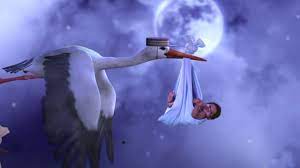 It is one of many unusual bequests in his will, along with giving a vacation home in Jamaica to a group of three men who detested each other under the condition that they live in the estate together indefinitely, brewery stocks to a group of prominent teetotal Protestant ministers if they participated in its operations and collected its dividends, and jockey club stocks to a group of anti-horse-racing advocates.
It is one of many unusual bequests in his will, along with giving a vacation home in Jamaica to a group of three men who detested each other under the condition that they live in the estate together indefinitely, brewery stocks to a group of prominent teetotal Protestant ministers if they participated in its operations and collected its dividends, and jockey club stocks to a group of anti-horse-racing advocates.
Litigation over the validity of the contest was resolved when the Supreme Court of Canada upheld the clause’s validity. The Court further held the clause did not encompass children born out of wedlock, or stillborn.
Eleven families competed in the “baby race.” Seven of them were disqualified, but eventually Judge William Edward Middleton ruled in favour of four mothers (Annie Katherine Smith, Kathleen Ellen Nagle, Lucy Alice Timleck and Isabel Mary Maclean) who each received $110,000 for their nine children ($2.02 million in 2021 dollars). Three of the four had to pay back relief money given to them by the City of Toronto government. Two of the disqualified candidates, Lillian Kenny and Pauline Mae Clarke, each received $12,500 out of court in exchange for abandoning pending appeals.
(I think old Chuck Millar had way too much money and time on his hands.)
Stuxnet is a malicious computer worm first uncovered in 2010 and thought to have been in development since at least 2005. Stuxnet targets supervisory control and data acquisition (SCADA) systems and is believed to be intentionally responsible for causing substantial damage to the nuclear program of Iran. Although neither country has openly admitted responsibility, the worm is widely understood to be a cyberweapon built jointly by the United States and Israel in a collaborative effort known as Operation Olympic Games. The program, started during the Bush administration, was rapidly expanded within the first months of Barack Obama’s presidency.
Stuxnet specifically targets programmable logic controllers (PLCs), which allow the automation of electromechanical processes such as those used to control machinery and industrial processes including gas centrifuges for separating nuclear material. Exploiting four zero-day flaws, Stuxnet functions by targeting machines using the Microsoft Windows operating system and networks, then seeking out Siemens Step7 software.
Stuxnet reportedly compromised Iranian PLCs, collecting information on industrial systems and causing the fast-spinning centrifuges to tear themselves apart. Stuxnet’s design and architecture are not domain-specific, and it could be tailored as a platform for attacking modern SCADA and PLC systems (e.g., in factory assembly lines or power plants), most of which are in Europe, Japan, and the United States. Stuxnet reportedly ruined almost one-fifth of Iran’s nuclear centrifuges. Targeting industrial control systems, the worm infected over 200,000 computers and caused 1,000 machines to physically degrade.
Stuxnet has three modules: a worm that executes all routines related to the main payload of the attack; a link file that automatically executes the propagated copies of the worm; and a rootkit component responsible for hiding all malicious files and processes, to prevent detection of Stuxnet crossing any. It is typically introduced to the target environment via an infected USB flash drive, thus air gap. The worm then propagates across the network, scanning for Siemens Step7 software on computers controlling a PLC. In the absence of either criterion, Stuxnet becomes dormant inside the computer. If both the conditions are fulfilled, Stuxnet introduces the infected rootkit onto the PLC and Step7 software, modifying the code and giving unexpected commands to the PLC while returning a loop of normal operation system values back to the users.
(I’m stealing this for a book plot.)
A Yaodong or “house cave” is a particular form of earth shelter dwelling common in the Loess Plateau in China’s north. They are generally carved out of a hillside or excavated horizontally from a central “sunken courtyard”.
The earth that surrounds the indoor space serves as an effective insulator, keeping the inside of the structure warm in cold seasons and cool in hot seasons. Consequently, very little heating is required in winter, and in summer, it is as cool as an air-conditioned room.
The history of yaodongs goes back centuries, and they continue to be used. In 2006, an estimated 40 million people in northern China lived in yaodongs.
In the last decade, yaodongs have been brought to the attention of scientists and researchers. These traditional dwellings have been regarded as an example of sustainable design.
Adolf Hitler Uunona is a Namibian anti-Apartheid activist and politician. He has been the councilor of the South-West Africa People’s Organization many times since 2004. He became famous in 2020 when news sources wrote he had been named after Nazi dictator Adolf Hitler.
The World Sauna Championships were an annual endurance contest held in Heinola, Finland, from 1999 to 2010. They originated from unofficial sauna-sitting competitions that resulted in a ban from a swimming hall in Heinola. The Championships were first held in 1999 and grew to feature contestants from over 20 countries. Sauna bathing at extreme conditions is a severe health risk: all competitors competed at their own risk, and had to sign a form agreeing not to take legal action against the organizers. Notably, the Finnish Sauna Society strongly opposed the event.
 After the death of one finalist and near-death of another during the 2010 championship, the organizers announced that they would not hold another event. This followed an announcement by prosecutors in March that the organizing committee would not be charged for negligence, as their investigation revealed that the contestant who died may have used painkillers and ointments that were forbidden by the organizers.
After the death of one finalist and near-death of another during the 2010 championship, the organizers announced that they would not hold another event. This followed an announcement by prosecutors in March that the organizing committee would not be charged for negligence, as their investigation revealed that the contestant who died may have used painkillers and ointments that were forbidden by the organizers.
The championships began with preliminary rounds and ended in the finals, where the best six men and women would see who could sit in the sauna the longest. The starting temperature in the men’s competition was 110 °C (230 °F). Half a litre of water was poured on the stove every 30 seconds. The winner was the last person to stay in the sauna and walk out without outside help. The host country usually dominated the event, as only one foreign competitor ever made it into the finals in the men’s competition. The first non-Finnish winner in the women’s competition was Natallia Tryfanava from Belarus in 2003.
Rules
- The starting temperature is 110 degrees Celsius. Half a litre of water will be poured on the stove every 30 seconds.
- Use of alcohol is prohibited prior to and during the competition.
- Competitors must wash themselves beforehand and remove any creams and lotions.
- Competitor must sit erect, their buttocks and thighs on the bench.
- Ordinary swimsuits must be used. Pant legs in men’s swimsuits may be up to 20 centimetres long, and women’s shoulder straps may be up to 5 centimetres wide.
- Hair that reaches the shoulders must be tied into a ponytail.
- Touching the skin and brushing is prohibited.
- Competitors must not disturb each other.
- At the request of the judges, competitors must show that they are in their senses with a thumbs up.
- Competitors must be able to leave the sauna unaided to qualify.
- A breach of the rules results in a warning. Another one results in disqualification.
- The last person leaving the sauna unaided is the winner.
Dancing Mania (also known as dancing plague, choreomania, St. John’s Dance, tarantism, and St. Vitus’ Dance) was a social phenomenon that occurred primarily in mainland Europe between the 14th and 17th centuries. It involved groups of people dancing erratically, sometimes thousands at a time. The mania affected adults and children who danced until they collapsed from exhaustion and injuries. One of the first major outbreaks was in Aachen, in the Holy Roman Empire (in modern-day Germany), in 1374, and it quickly spread throughout Europe; one particularly notable outbreak occurred in Strasbourg in 1518 in Alsace, also in the Holy Roman Empire (now France).
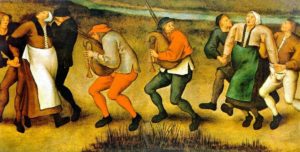 Affecting thousands of people across several centuries, dancing mania was not an isolated event, and was well documented in contemporary reports. It was nevertheless poorly understood, and remedies were based on guesswork. Often musicians accompanied dancers, due to a belief that music would treat the mania, but this tactic sometimes backfired by encouraging more to join in. There is no consensus among modern-day scholars as to the cause of dancing mania.
Affecting thousands of people across several centuries, dancing mania was not an isolated event, and was well documented in contemporary reports. It was nevertheless poorly understood, and remedies were based on guesswork. Often musicians accompanied dancers, due to a belief that music would treat the mania, but this tactic sometimes backfired by encouraging more to join in. There is no consensus among modern-day scholars as to the cause of dancing mania.
The several theories proposed range from religious cults being behind the processions to people dancing to relieve themselves of stress and put the poverty of the period out of their minds. It is speculated to have been a mass psychogenic illness, in which physical symptoms with no known physical cause are observed to affect a group of people, as a form of social influence.
— — —
I know this post is running on. If you’re still with me, I’ll shorten it up with some tidbits.
The Confederate Flag commonly seen today was never actually used in the United States Civil War. It’s a 20th-century phenomena.
Ala Kachuu (Kyrgyx bride kidnappings) is a really weird practice.
Wikipedia: Unusual Articles — Be prepared to spend the entire day here.
Divorce Statistics from around the world.
FBI 10 Most Wanted Fugitives Yes, it includes women.
The Miracle of 1511 The Dutch made pornographic snowpeople to protest the emperor.
Diolkos The ancient Greeks built a railway.
Alfred Hensel won the 1928 Olympic gold medal for town planning.
In Thailand the current year is 2566.
Garden Hermits were real people, not ceramic gnomes.
A Chicken Named Mike lived for a year and a half after having his head chopped off.
California was once mapped as an island. They were wrong.
An 1859 Solar Flare wiped out most of the world’s telegraph system.
Prisencolinensinainciusol sounds like English to people who don’t speak English.
Troll 2 was one of the worst movies ever. It was not a sequel and had no trolls in it.
Soviet Leader Mikhail Gorbachev starred in a Pizza Hut commercial.
A List of Unusual Deaths Some of these are very unusual.
A List of Sexually Active Popes If you really want to know.

